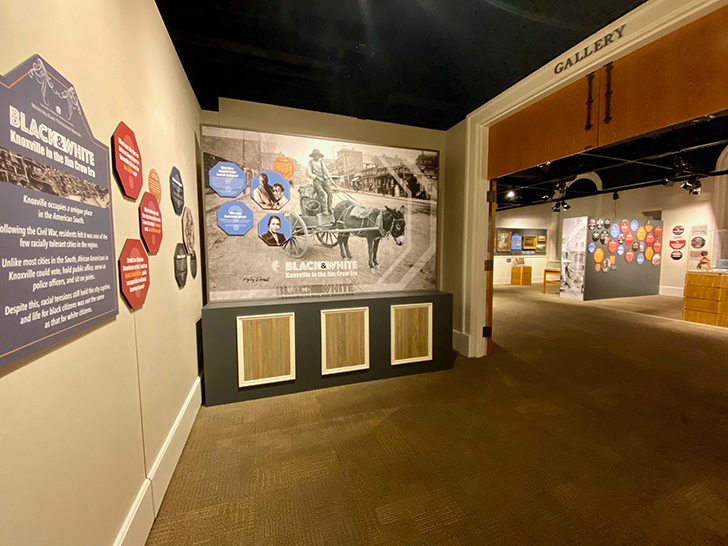| |

Display of the Jim Crow Era; image courtesy of the Museum of East Tennessee History
|
Knoxville occupies a unique place in the American South. Following the Civil War, residents felt it was one of the few racially tolerant cities in the region. Unlike most cities in the South, African Americans in Knoxville could vote, hold public office, serve as police officers, and sit on juries. Despite this, racial tensions still held the city captive, and life for black citizens was not the same as that for white citizens.
Through June 14th, the Museum of East Tennessee History will feature an exhibition depicting Knoxville in the Jim Crow era. The exhibition will be at the East Tennessee History Center, 601 S. Gay Street.
Despite Jim Crow laws and segregation that dictated much of the interaction between black and white citizens, African American artists carved out a place for themselves in Knoxville. A new feature exhibition Black & White: Knoxville in the Jim Crow Era at the Museum of East Tennessee History, explores what life was like for African Americans in Knoxville during the Jim Crow era. This exhibition, presented as a timeline, provides historical context to the lives of local African American artists Beauford Delaney, Joseph Delaney, and Ruth Cobb Brice. It seeks to answer what influence the city had on the early lives of these artists and whether they could succeed without leaving home.
Brothers Beauford and Joseph Delaney were internationally known artists whose works are now part of some of the world's most prestigious collections. The Delaneys were born in Knoxville in the aftermath of slavery and the Civil War. Their education was often informal and sporadic, as they attended one rural school after another while traveling with their circuit-riding preacher father. They grew up amidst racial segregation, witnessed the upheaval of Knoxville’s race riot in 1919, and were aware of the lynching of blacks throughout the South. They were part of the Great Migration, during which thousands of African Americans left the South looking for opportunities. Beauford and Joseph took different paths, yet their paintings reflect the world they experienced, beginning with life in Knoxville.
Ruth Cobb Brice was a Knoxville-born educator, writer, and artist contemporary with Beauford and Joseph Delaney. Like the Delaneys, Brice grew up amidst racial segregation. But unlike them, Brice worked from Knoxville. Even without the direct influence of large art centers, Brice’s paintings and poems gained national notoriety.
About Black & White: Knoxville in the Jim Crow Era
The Museum of East Tennessee History will feature Black & White: Knoxville in the Jim Crow Era, on view from February 14, 2020, through June 14, 2020. The exhibition highlights three African American artists from Knoxville — Beauford Delaney, Joseph Delaney, and Ruth Cobb Brice — and how Knoxville during the Jim Crow era shaped their lives and careers.
The exhibition includes 66 artifacts highlighting the history of race relations, African American art, and the development of an art community in Knoxville following the Civil War. 45 of these artifacts are on loan to the Museum of East Tennessee History from the Calvin M. McClung Historical Collection, Beck Cultural Exchange Center, and private donors. The exhibition features several videos including Knoxville’s Red Summer: The Riot of 1919 and Beauford Delaney, both courtesy of East Tennessee PBS and Black Appalachia; and The Civil Rights Movement in Knoxville courtesy of the Tennessee Archive of Moving Image and Sound. A variety of artworks by the highlighted artists are on display as well as works from other Knoxville-based artists who influenced them.
There is an assortment of artifacts reflecting the racial mentality of Knoxvillians following the Civil War. One case contains a variety of “Mammy” dolls, a stereotypical portrayal of African American women, and another case highlights African American stereotypes as presented through local photographers, the Knaffl Brothers. Other artifacts include items from the Appalachian Exposition of 1910 and a seat from the Gem Theatre, which opened in 1913 and was the South’s largest black theater.
The East Tennessee Historical Society developed the exhibition with guest curator Robert J. Booker and research assistance provided by the staff of the Calvin M. McClung Historical Collection, Knox County Public Library. The exhibit is on view at the Museum of East Tennessee History through June 14, 2020. We encourage patrons to view the exhibition in tandem with the Knoxville Museum of Art exhibition Through the Unusual Door (through May 7, 2020), which provides a groundbreaking look at Beauford Delaney and his creative exchange with writer James Baldwin.
The Museum of East Tennessee History is open 9:00 a.m. to 4:00 p.m., Monday through Friday; 10:00 a.m. to 4:00 p.m., Saturday; and 1:00 p.m. to 5:00 p.m., Sunday. Museum admission is $5.00 for adults, $4.00 for seniors, and FREE for children under 16. Each Sunday admission is FREE to all and ETHS members always receive FREE admission. The Museum is located in the East Tennessee History Center, 601 South Gay Street, Knoxville, TN 37901. For more information about the exhibition, scheduling a school tour, or visiting the museum, call (865) 215-8824, email eths@eastTNhistory.org, or visit www.easttnhistory.org.
About East Tennessee Historical Society
Established in 1834, the East Tennessee Historical Society is widely acknowledged as one of the most active history organizations in the state and enjoys a national reputation for excellence in programming and education. For 185 years the East Tennessee Historical Society has been helping East Tennesseans hold on to our unique heritage—recording the events, collecting the artifacts, and saving the stories that comprise the history we all share.

